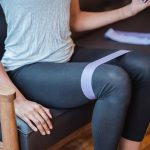Looking to expand your waistband without buying a new pair of pants? You've come to the right place.
When your favorite bottoms feel a bit snug, there's no need to bid them farewell. With these 5 expert techniques, you can easily make your waistband bigger and ensure a comfortable fit.
From adding elastic inserts to utilizing a ruching technique, these methods will give you the extra room you need while maintaining a polished look.
Whether it's for a temporary fix or a long-term solution, mastering these waistband expansion methods will help you confidently tackle any snug pants situation.
Key Takeaways
- Elastic inserts can be used to create a more comfortable fit in waistbands by adjusting the elastic.
- Fabric panels can be added to waistbands to custom tailor the fit of the garment.
- Waistband extenders can provide extra room in waistbands without altering the original waistband.
- The ruching technique can be used to add flexibility and accommodate fluctuations in body size in waistbands.
Loosen the Waistband With Elastic Inserts
You can easily loosen the waistband of your clothing by inserting elastic to create a more comfortable fit. This sewing technique is particularly useful for adjusting elastic waistbands on skirts, pants, or shorts.
Firstly, determine how much additional room you need in the waistband. Then, measure and cut a piece of elastic slightly shorter than the measured length. Use a safety pin to guide the elastic through the casing of the waistband, ensuring it's evenly distributed. Once in place, securely stitch the ends of the elastic together.
This simple method allows for a flexible and adjustable waistband, providing a personalized fit without compromising on style or comfort.
Elastic waistbands are a versatile feature in clothing, offering both convenience and ease of wear. By mastering this sewing technique, you can effortlessly tailor your wardrobe to your specific measurements, ensuring that your garments always fit just the way you like.
Whether you're a seasoned seamstress or a novice in the world of sewing, learning how to modify elastic waistbands will undoubtedly enhance your clothing customization skills.
Add Fabric Panels for Extra Room
To add extra room to a waistband, consider sewing in fabric panels to accommodate your specific measurements. When your waistband feels too tight, adding fabric panels is a custom tailoring technique that can provide the extra space you need. This method involves cutting the waistband at the sides or back and inserting fabric panels to increase the overall circumference. Sewing techniques like this require precision and attention to detail. When adding fabric panels, fabric manipulation is key to ensuring a seamless and natural look. You'll need to carefully match the fabric type, pattern, and color to seamlessly integrate the panels into the original garment.
Waistband alterations through the addition of fabric panels are a great way to personalize your clothing for a better fit. This method allows you to maintain the original look of the garment while providing the extra room you need. With custom tailoring, you can ensure that the added fabric panels blend in seamlessly, creating a natural and comfortable extension to your waistband.
Extend the Waistband With a Waistband Extender
If your waistband feels too tight, consider extending it with a waistband extender to provide extra room for a more comfortable fit. Waistband extenders are simple yet effective tools that can help alleviate the discomfort of a too-snug waistband.
Here's how to extend your waistband with a waistband extender:
- Select the Right Extender: Choose a waistband extender that matches the color and style of your garment for a seamless look.
- Attach the Extender: Hook the extender onto the button of your pants or skirt, then loop the extender's button through the buttonhole to secure it in place.
- Adjust for Comfort: Use the different slots on the extender to find the most comfortable setting for your waistband size.
- Enjoy the Added Comfort: With the extender in place, you can now enjoy a more comfortable fit without the need to alter the original waistband.
Use a Ruching Technique for a Stretchy Waistband
Achieve a stretchy waistband by employing a ruching technique, which involves gathering and sewing elastic to the existing waistband for added flexibility and comfort. Ruching benefits the waistband by allowing it to expand and contract with ease, accommodating fluctuations in body size.
To apply this method, cut a piece of elastic slightly shorter than your waist measurement and secure one end to the side seam of the waistband. Using a straight stitch, sew the other end of the elastic to the opposite side seam, stretching the elastic as you sew to create ruching. This technique evenly distributes the stretch and prevents uncomfortable tightness at specific points.
Additionally, you can gather the fabric between the elastic to create a decorative ruched effect. When using this method, be mindful of the fabric's stretch and the elasticity of the chosen elastic to ensure a comfortable and functional stretchy waistband.
Opt for a Wrap-around Waistband Extension
Consider using a wrap-around waistband extension to easily increase the size of your waistband. This simple and effective technique allows you to maintain the original look of your garment while providing the extra space you need.
Here are some tips for using a fabric extension and styling options for a wrap-around design:
- Fabric Extension: Look for a matching or complementary fabric to create the extension. Cut a strip of fabric that matches the width of your waistband and the length needed to provide the desired extension. This will ensure a seamless blend with your existing waistband.
- Sewing Tips: Secure the fabric extension to the waistband by sewing it along the top and bottom edges. Make sure to use a sturdy stitch to ensure the extension is secure and can withstand regular wear.
- Wrap Around Design: Opt for a wrap-around style extension that can be easily adjusted to provide the perfect fit. This design allows for flexibility and comfort, accommodating changes in waist size while maintaining a polished appearance.
- Styling Options: Experiment with different fabric patterns and textures to add a unique touch to your garment. Consider incorporating decorative elements such as buttons or ties to enhance the overall look of the extended waistband.
Frequently Asked Questions
Can I Use These Methods to Make the Waistband of My Jeans Bigger, or Are They Only Suitable for Certain Types of Clothing?
You can definitely use these methods to make the waistband of your jeans bigger. They are suitable for various types of clothing, and with some simple jeans modification, you can achieve a comfortable fit.
Will These Methods Work for Waistbands That Have Belt Loops or Decorative Elements?
Yes, sewing techniques can be used to adjust waistbands with belt loops. You can modify the belt loops and even add extra fabric to make the waistband larger. Elastic waistbands can also be adapted to accommodate decorative elements.
Are There Any Specific Types of Fabric or Materials That Work Best for Each of These Methods?
For making a waistband bigger, the best fabric types include stretch denim or cotton blends. Suitable materials are elastic or fabric extender. Limitations vary based on specific clothing items, but these options generally work well.
Can These Techniques Be Used to Make the Waistband Bigger by a Significant Amount, or Are They Only Suitable for Small Adjustments?
You can use these techniques to make the waistband bigger by a significant amount. They are not just for small adjustments. You can make the waistband of your pants bigger without altering the overall fit.
Are There Any Special Considerations or Adjustments I Need to Make if I Want to Use These Methods on a Skirt or Dress With a Zipper Closure?
When adjusting a waistband size on a skirt or dress with a zipper closure, consider the placement of the zipper and the sewing techniques required. Modifications may be needed to ensure a smooth transition and secure fit.
- Tetron Fabric for Marine Applications: Durability and Use Cases - June 18, 2025
- Tetron Fabric for Outdoor Furniture: Weather Resistance and Care - June 18, 2025
- Tetron Fabric for Wall Coverings: Style and Application Tips - June 18, 2025






